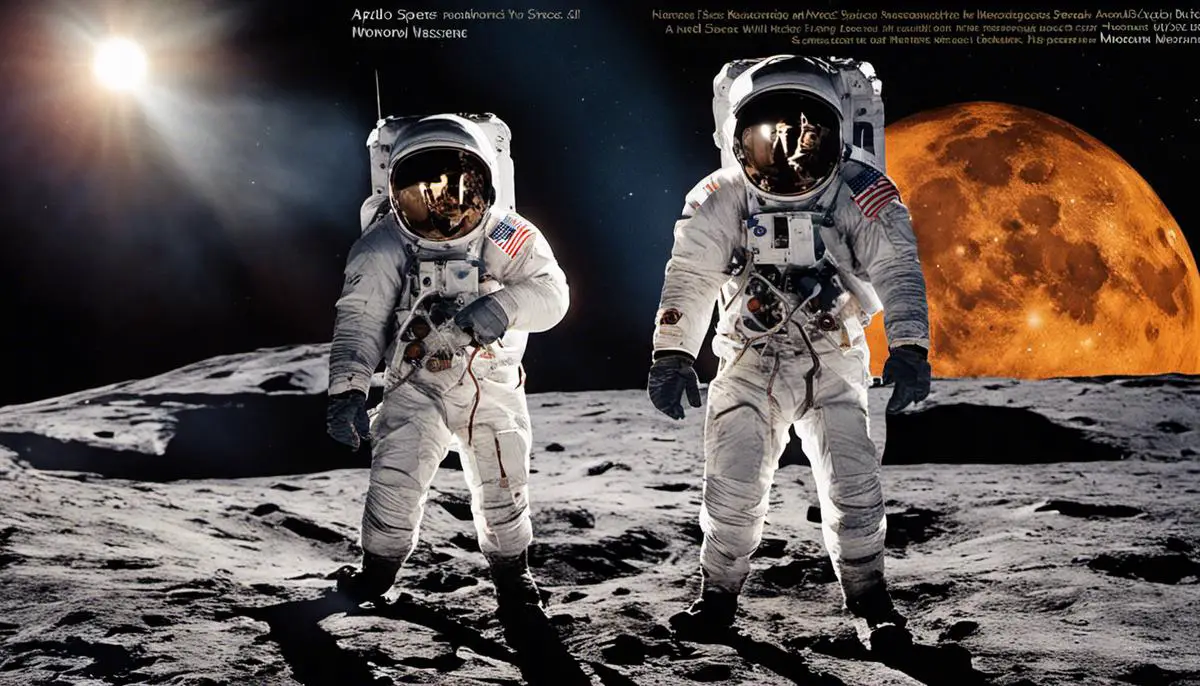In the annals of human history, few events have had the same dramatic and pervasive influence as the Apollo lunar missions. The period from 1961 to 1972, when these missions were carried out, stands out as a landmark era, punctuated by extraordinary technological achievements, fierce geopolitical rivalry, and an unprecedented exploration of our celestial neighbor. The Apollo programs’ significance transcends the domains of science and technology, seeping into our culture, impacting our collective psyche, and shaping our view of the cosmos.
Contents
Historical context of the Apollo missions
The Apollo Program
The Apollo program, also referred to as Project Apollo, was a significant series of space missions conducted by NASA, the United States’ national civilian space arm, between 1961 and 1972. The program was launched in response to the Soviet Union’s achievements in space exploration, marking a crucial phase in the Cold War era confrontation known as the Space Race.
The Space Race
The Space Race between USA and USSR was an intense competition to establish dominance in spaceflight capability. It was triggered by the Soviet Union’s success in launching the world’s first artificial satellite, Sputnik, in 1957. The USA took these advancements as a challenge. To catch up to, and eventually, surpass Soviet accomplishments in space, NASA was established in 1958. The Mercury and Gemini programs launched by NASA served as precursors to the Apollo missions in terms of technology and personnel training.
Yuri Gagarin’s Orbit and Kennedy’s Decision
On April 12, 1961, Yuri Gagarin of the USSR became the first man to orbit Earth, further escalating the Space Race. The USA felt immense pressure not just to achieve parity but to demonstrate superiority in space. President John F. Kennedy, recognizing the psychological and strategic implications of Soviet success in space, made the bold decision to send Americans to the Moon.
Kennedy’s Moon Speech
On May 25, 1961, in a special joint session of Congress, President Kennedy made his famous moon speech. He proclaimed, “I believe that this nation should commit itself to achieving the goal, before this decade is out, of landing a man on the Moon and returning him safely to the Earth.” This speech was not merely about reaching the moon; it was a call to win the Space Race and a proclamation of America’s technological and exploratory prowess.
The Apollo Program’s Objectives
Kennedy’s speech marked the official start of the Apollo program. Despite its hefty cost, the Apollo program was not merely about national pride and space supremacy. The program was one of exploration and scientific discovery. It aimed at hard technological targets with a broad spectrum of societal benefits. The scientific knowledge and technological advances obtained from the Apollo program have contributed significantly to the fields of Earth and planetary science, astronomy, and human health.
Apollo 11: The Moon Landing
Apollo 11, specifically, the mission that fulfilled Kennedy’s goal, holds a special place in history. On July 20, 1969, astronaut Neil Armstrong became the first man to step foot on the lunar surface, followed closely by Buzz Aldrin. The mission returned a rich trove of scientific data and 48.5 pounds of lunar material. This mission impacted not only science and technology but also culture, politics, and philosophy.
The Unforgettable Legacy of the Apollo Missions
The Apollo missions stand as a monument to human determination and innovation. They are the ultimate symbol of mankind’s potential, reflecting an incredible triumph of engineering and organization. Moreover, these lunar expeditions laid the foundation for current and future space explorations. They continue to incite passion in the hearts of scientists, engineers, and dreamers worldwide.

Photo by joehan330 on Unsplash
Technical achievements and the scientific significance
Groundbreaking Apollo Technology
The Apollo moon missions heralded significant progress in technology, particularly the Saturn V rocket, Lunar Module, and Command Module. Standing an astonishing 363 feet tall, the Saturn V rocket embodied the grand dreams of humans during that era. This unparalleled engineering marvel was crucial in sending the Apollo command module, service module, and lunar module into space. It remains unmatched in terms of height, weight, and power.
The Lunar Module, fondly named the ‘Eagle,’ was a two-level vehicle designed specifically to ferry two astronauts from lunar orbit to the moon’s surface and back. It featured a unique design that allowed astronauts to land on the moon without the hassle of taking off again. The ‘Eagle’ was built to endure the unknown, harsh conditions such as the extreme temperature shifts and the vacuum-like environment of the lunar surface.
The Command Module was the primary living area for the astronauts during the Apollo missions. It was the singular component of the entire spacecraft that returned to Earth. The module was specially crafted to shield the astronauts during the fiery re-entry into Earth’s atmosphere and the final splashdown.
Scientific Experiments on the Lunar Surface
One of the major objectives of the Apollo missions was to conduct scientific experiments on the lunar surface. An array of tools and instruments, collectively known as Apollo Lunar Surface Experiments Package (ALSEP), were used. These included seismometers to analyze ‘moonquakes’ and internal structure of the moon, solar wind spectrometer to study the impact of the solar wind on the lunar surface, and dust detector to measure the deposition of lunar dust on equipment.
Discoveries and Implications
The Apollo Moon missions resulted in numerous important discoveries. One of the most significant was the understanding of the moon’s geology and its relationship with Earth. The astronauts collected a copious amount of lunar rocks and soil for analysis back on Earth. The studies from these samples suggested that the moon was not a primitive body as earlier believed, but had undergone the process of differentiation and volcanic activity.
The moon’s lack of magnetic field was another surprising discovery. This gave insights into the moon’s core and internal structure, vastly different from that of Earth. Moreover, study of the lunar soil indicated that the moon had been bombarded with intense micrometeorites in its early years, leading to an ‘ageing’ surface, which held implications for understanding the early history of the solar system.
The Influence of Apollo’s Moon Missions on Space Exploration
The Apollo space program was a significant game changer in the domain of space exploration. These missions have not only given us a better perspective with regards to safety during space fligths, but also an insight into how humans adapt to the challenging environment in space. These landmark missions weren’t merely stepping stones for further space exploration and technological advances, but they also tremendously impacted our quality of life back here on Earth. Quite importantly, the Apollo program offered an insight into mankind’s capabilities when it comes to exploration, discovery, and technological innovation. These missions challenged our understanding of the limits of human potential and significantly deepened our knowledge and comprehension of the expansive universe.

Sociocultural impact and legacy of the Apollo program
How the Apollo Missions Shaped Popular Culture
On an influential note, the Apollo moon missions also had a lasting imprint on various aspects of popular culture, primarily in the United States, but their reach was essentially global. The moon landing was watched by an astonishing 600 million people worldwide through televised broadcasts, forever etching the image of an astronaut walking on the lunar surface into our collective consciousness. This seminal event became a rich source of inspiration and led to the creation of numerous films, television series, books, music, and artwork, all striving to embody the awe and significance of the human journey to the moon. References to Apollo can be found in numerous cultural cornerstones, ranging from Stanley Kubrick’s landmark film, “2001: A Space Odyssey,” to the popular ABC TV series, “The Astronaut Wives Club.” Such examples only reiterate the pervasive influence the Apollo missions have had on our cultural landscape.
Inspiring Generations
The Apollo moon missions were not only a technical and scientific triumph but also a source of inspiration for generations to come. The missions sparked a fascination with space, encouraging many young people to pursue careers in science, technology, engineering, and math (STEM). They also fostered a sense of global unity, even if momentarily, as people around the world watched in awe as humans stepped onto another celestial body for the first time.
Global Perception of Space Exploration
Arguably, one of the most significant impacts of the Apollo moon missions was the shift in global perception towards space exploration. The missions highlighted the possibilities of human ingenuity and determination, making space not just a subject of scientific curiosity but a domain of human activity. This awareness led to the establishment of multiple space agencies across the globe, an increased interest in science education, and popular enthusiasm for space exploration.
The Ongoing Legacy of the Apollo Program
The Apollo moon missions have also left an enduring legacy that influences current and future space missions. The Lunar Roving Vehicle (LRV), also known as the “moon buggy”, developed during the Apollo program has paved the way for the Mars rovers currently exploring the Martian surface. The technological advancements and scientific discoveries made during the Apollo missions continue to be utilized in modern science and engineering.
Several space agencies and private companies are now setting their sights on the moon again, either for scientific research or as a stepping stone for future missions to Mars. NASA’s Artemis program, which aims to return humans to the moon by 2024, calls upon the history of the Apollo missions while also carving out new paths in the realm of space travel and exploration.
Without the Apollo Program
Without the Apollo program, our understanding and exploration of space might not look the same. The missions sparked interest in space globally, inspired countless technological developments, provided invaluable scientific knowledge, and forever changed the human perspective of our place in the universe—their significance cannot be overstated.

Photo by nickbrunner on Unsplash
Indeed, from its historical underpinnings in the heat of the Cold War, the myriad technological innovations, to the far-reaching sociocultural impacts, the Apollo missions have undeniably etched an indelible mark on the human civilization. The footprints and flag planted on the lunar surface may fade over time, but the influence of these moon missions continues to inspire us to look beyond our planet, to explore the unknown, and to continually push the boundaries of our capabilities. Above all, the Apollo moon missions remind us of what humanity can accomplish when we collectively strive for daring, transcendent goals.

With a passion for unraveling the mysteries of the moon, Dr. Luna Sterling is a highly-respected astrophysicist, a dedicated lunar enthusiast, and a captivating blogger. After earning her Ph.D. in Astrophysics from the Massachusetts Institute of Technology (MIT), she served as a lead scientist and mission planner for NASA, contributing significantly to various lunar missions.
For over two decades, Luna has been at the forefront of lunar science, pushing boundaries and pioneering discoveries that have enriched our understanding of the moon’s geological history. However, it’s her infectious enthusiasm for all things lunar that truly sets her apart.
In an endeavor to bring the moon closer to everyone, Luna started her blog, “Luna’s Lens: A Closer Look at the Moon.” With this platform, she offers a unique blend of intriguing moon facts, updates on lunar missions, and personal anecdotes from her experiences in the field, all told in an engaging and accessible manner.
Luna’s unique blend of scientific expertise and warm, humorous writing style has transformed complex astrophysics into compelling narratives that captivate her audience. As a gifted communicator, she leverages her knowledge and experience to relate scientific facts to everyday life, thus making her blog a must-read for both seasoned space enthusiasts and curious newcomers.
Interactive and inviting, Luna frequently encourages reader engagement through thought-provoking discussions and a monthly ‘Ask Dr. Luna’ feature, where she personally answers questions about the moon and space exploration. A celestial storyteller at heart, Dr. Luna Sterling’s passion for the moon is as vast as the cosmos she explores, making her an invaluable beacon in the world of lunar science.
